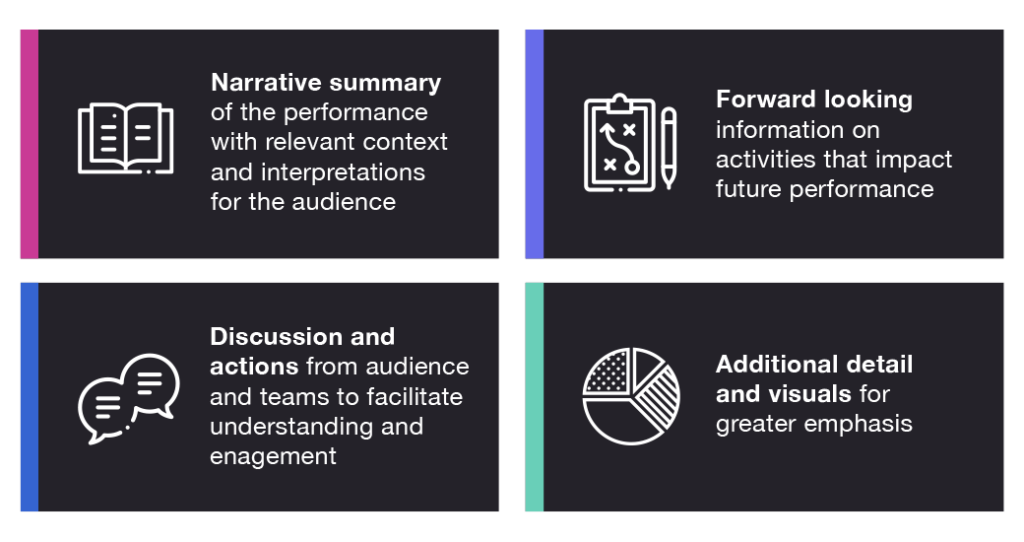Narrative reports are a quick, low-cost investment to improve communication and engagement with business leaders.
Executive leaders often ask their teams for better data storytelling in executive dashboards and reports. These leaders often have difficulty making sense of the vast array of charts, metrics, and filters—features that are typically intended to clarify, not confuse. What leaders truly want is a fast and easy way to visualize business performance and key takeaways.
Adding more data storytelling may seem like a rational approach to meeting this need, but there’s a better and more practical solution that deserves your consideration: Narrative Reporting
Narrative reports deliver a clear picture of business performance, along with necessary context and interpretations for leaders to act on.
Most Analytics leaders would agree: it’s a constant challenge just to update and share business performance data with leadership teams every week. Analysts commonly resort to quick dashboard screenshots when sharing updates with leaders, in the hopes that simply presenting all of the information will result in more answers and fewer questions. Unfortunately, this just creates more confusion and often leads to frustration all around.
In this article, we’ll share a solution that enables teams to move beyond traditional reporting towards the more effective approach of narrative reporting. Narrative reports deliver a clear picture of business performance, along with necessary context and interpretations for leaders to act on.
Is narrative reporting the same as data storytelling?
It’s easy to confuse data storytelling and narrative reporting. They both leverage narratives, visuals, and data, but each one has a noticeably different use case and outcome for your organization.
Narrative reporting is about ongoing performance clarity
Performance dashboards are typically excellent for tracking and displaying data in charts and graphs. However, they lack the important context and interpretations necessary to fully understand why the metrics changed.
Narrative reports go beyond just delivering recent performance data at a set interval. They include key context, explanations, and interpretations of the data to help your audience see beyond data to the broader causes and outcomes that inform powerful business decisions.
Narrative reporting gives you a macro-view of performance, with context, color, and perspective.
Data storytelling is about inspiring action from insight
Data stories are best used in response to an urgent issue. For example, you might use data storytelling when you need to convince or inspire an audience to take immediate action based on a recently discovered insight.
A data story can’t be scheduled or created in a dashboard. It must be developed around an important discovery that has meaningful value to an organization when acted upon. It’s important to develop a complete story that clearly explains the context of the insight, the impact it has on the organization’s goals, and the options the audience has to consider before taking action.
Data storytelling gives a micro-view of a critical insight that requires immediate attention by an audience.
Each of these has a unique place in your analytics toolbox, but both rely on narrative as a core function for facilitating understanding in a structured format.
Creating a narrative report is often less involved than creating a data story, and it’s a more common output for data teams and business leaders to work with. Data stories are important to be told but building the process and maturity for regularly delivered narrative reports should be a critical priority for most organizations.
For executives, narrative reporting is a common practice
The term “narrative reporting” may seem foreign to some, but it’s one of the most common forms of public reporting within large enterprises. Annual reports or Form 10-K filings published by publicly traded companies are essentially narrative reports. These reports are required by regulators, and they disclose recent financial performance — including a narrative of that performance authored by the management team.
These narratives are designed to help investors interpret recent business performance and understand how that performance aligns with the management decisions and learnings. They also offer forward-looking guidance and describe the future opportunities and vision the organization is driving towards.
Annual reports published by publicly traded companies are essentially narrative reports designed to help investors interpret performance and understand decisions.
Without these narratives, investors may not fully appreciate the circumstances of the business performance or hold confidence in the management team’s ability to deliver shareholder value.
This same narrative approach can be extended to internal teams and leaders to better align, inform, and guide business outcomes.
Narrative reports bring several benefits
A narrative report is designed to facilitate a common understanding and dialogue around business performance. The report is a major artifact in itself, but its biggest impact lies in how it can improve an organization’s data culture across teams and leadership.
Improved clarity & interpretations
One notable improvement over traditional reporting is the inclusion of performance explanations and interpretations. When a metric moves significantly either way, providing the context of “why” and “how” provides greater clarity and understanding for leaders.
Common understandings
When reports are driven by a narrative, teams can align around a common understanding that provides a solid foundation for discussion and debate. Without a common narrative to rely on, people tend to formulate different narratives that can stymy productive conversations.
Forum for discussing data and actions
This is arguably the greatest benefit of narrative reporting. When it comes time to discuss performance data, teams and leaders need to know why a given change occurred and what actions should be considered going forward. Narrative reporting powers richer, more meaningful discussions that support faster decision making.
Relatively low cost to implement
Narrative reporting doesn’t require any specific software tool or capital expense. Instead, it’s about maturing your existing reporting process into one that brings context, aids interpretation, and fosters more productive discussions. In some cases, you may be able to leverage existing analytics software to make the process more efficient. The primary cost comes in the form of time and resources: Business leaders must allocate more of both in order for teams to build sufficient context and deliver accurate interpretations.
The power behind narrative reporting for analytics teams
Some analytics teams see multiple performance dashboards as the end goal of their work—but these same teams often see their dashboards fail the test with business leaders when long-term benefits don’t materialize.
Before trying to force leaders into using dashboards, we must first understand why current dashboards aren’t supporting their needs. Some leaders don’t trust dashboard data, and some simply aren’t comfortable using a dashboard. For most, however, the problem stems from experiences with dashboards that don’t provide them with the clarity and understanding they seek. Charts and metrics may be plentiful, but without the right context many dashboards fail to deliver any real value.
What executives really want are reports that support clear understanding and better decisions by providing the necessary interpretations of performance metrics.
We’ve consistently heard the same thing from executives we have spoken to: what they want and need from their teams is a report that supports clear understanding and better decisions by providing the necessary interpretations of performance metrics.
We can further break this down into the following key questions leaders are consistently seeking answers to:
- What forces are impacting current and future outcomes?
- What actions can leaders take to impact the forces and outcomes?
- How can leaders support and execute those actions?
Most analytics teams won’t find the answers to the first two questions by looking at data alone. Finding the real answers requires deep collaboration and discussion across teams and organizations. Only then can teams gain a true understanding of the whole picture, including the many different forces that lead to a given outcome.
It’s key that the authors of your narrative reports connect with the operating teams that drive the activities impacting your business performance. Beyond just knowing who to talk to, they must stay plugged into what these teams are doing and how it leads to key business outcomes. This connection strengthens overall understanding of the forces impacting your business.
Key elements of narrative reports
A narrative report typically contains the following core elements, which are determined by the organization’s key metrics. In some cases, you can refine an existing business report by adding the following narrative elements.
- Narrative summary of performance: Relevant context and interpretations overlaid against current performance metrics and outcomes. What are the known causes impacting or influencing this performance?
- Forward-looking information: Information about activities that may impact future performance. How should past performance and activities inform future actions and expectations?
- Discussion and actions: A dedicated area to track and facilitate discussion amongst leaders and teams. How is your team collaborating and engaging with the content to influence and improve outcomes?
- Additional visuals and deeper explanations: Any additional written or visual information that can enrich the reader’s understanding.

Best practices for enabling narrative reports in your organization
Commit to engagement
Narrative reporting is one of the easiest ways to align leaders and teams. It provides a clear and common approach to sharing and discussing business performance, but it absolutely requires both sides to fully buy into the approach. One side on its own can’t adequately manifest the value of narrative reporting. Both sides must demonstrate a strong commitment to empowering their teams to build interpretations of the data, and leaders need to commit to openly discussing and integrating their new understanding into future plans.
Establish a process and practice
A robust process powers your analytics team to move outside the dashboard space and pursue answers and understanding around the “whys” behind your organization’s performance. It’s no longer enough to simply report that sales were down last week; in order to promote real understanding, narrative reports must include context and potential reasons for these kinds of changes. Leaders must do their part by encouraging and fostering cross-team discussions and collaboration.
- Create a narrative report template to support an efficient and repeatable process for teammates. To make reading and understanding reports easier, design this template in a new and simple format that’s aligned to key business metrics and outcomes.
- Invest dedicated time to curating narrative reports. After organizing data into a common view, teammates must set aside time as a group to explore and discuss any changes in that data. It’s just not possible to deliver a good narrative report in the same time as traditional report — but it’s well worth the extra investment.
- Schedule a forum where teams can review and discuss narrative reports. The discussion should be rich and focused on what can be done in the future based on new understandings. It’s important that any actions or comments be captured within the narrative report so that readers understand how the discussion went.
Expand your analytics toolbox with narrative reporting
Narrative reporting can be an amazing new tool in your organization’s reporting toolbox. By combining business performance data with necessary context, you can build trust in your team and demonstrate the value narrative reports bring, while also delivering a clear picture that empowers teams to improve business outcomes.
Investing the necessary time and effort in improving your business reporting now will ultimately lead to a more efficient overall decision-making process across the organization.
Narrative reports pack a lot of value into a small package, yet it’s important to keep in mind that they’re just one stepping stone in the path towards giving leaders a true appreciation of data analytics. They will, however, greatly improve your organization’s data culture and habits around sharing and discussing that data across teams and leaders.
Organizations that invest the necessary time and effort in improving their business reporting will reap the benefits through a more efficient overall decision-making process across the organization.
If your teams struggle with communicating business performance, consider narrative reports as a quick, low-cost investment to improve communication and engagement with business leaders. If you need help to develop your narrative reporting process, increase adoption, or gain executive buy-in, contact the BlastX Consulting team for support.
Ready to dive even deeper into narrative reporting?
Don’t miss out on our June coffee chat with Amplitude!
Ever wondered how to transform raw data into actionable insights to propel your business forward? Sit down with Matthew Carmean and the Amplitude Team on June 27, 2024 at 9:00 a.m. PDT as they dive into the art and science of operationalizing dashboards, reports, and data storytelling using Amplitude.

